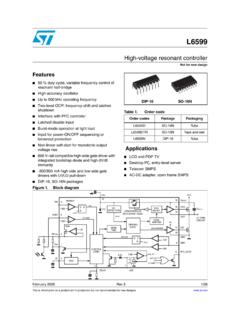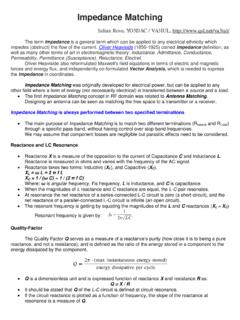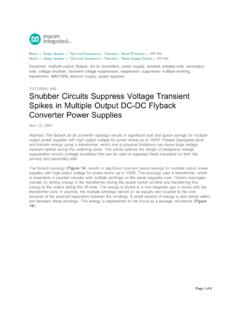Transcription of How to design an antenna for dynamic NFC tags ...
1 March 2019AN2972 Rev 91/261AN2972 Application noteHow to design an antenna for dynamic NFC tags IntroductionThe dynamic NFC (near field communication) tag devices manufactured by ST feature an EEPROM that can be accessed either through a low- power I2C interface or an RF contactless interface operating at MHz. Both short-range (ISO/IEC 14443 Type A) and long-range (ISO/IEC 15693) standards are 1. dynamic NFC tagsDynamic NFC tag can be used in many applications, with the requirement that the processor features an I2C application note intends to: explain the basic principle of passive RFID describe the basics of a MHz inductive antenna design provide guidelines for a successful integration, from design to b l e 1 lists the products concerned by this application note.
2 Table 1. Applicable productsTypeApplicable productsDynamic NFC tagsST25DV-I2C, ST25DV-PWM, M24LR and M24SR series Dynamics NFC Tags, & LQWHUIDFH 5) LQWHUIDFH((3520DL Rev 9 Contents1 Operating mode .. 52 Basic principles and equations .. RFID technology .. equivalent inlay circuit .. equations .. antenna tuning .. 103 How to design the antenna on a PCB .. of a circular antenna .. of a spiral antenna .. of a square antenna .. antenna design tool .. layout .. of the connections between dynamic NFC tag chip and antenna .)
3 , power , and signal layers .. surfaces .. 164 How to check the NFC/RFID dynamic NFC tag antenna tuning .. tuning measurements with a network analyzer .. measurements with standard laboratory tools .. 195 From design to production .. 216 Revision history .. 24AN2972 Rev 93/26AN2972 List of tables3 List of tablesTable products .. 1 Table and K2 values according to layout .. 12 Table compensation examples .. 16 Table revision history .. 24 List of figuresAN29724/26AN2972 Rev 9 List of figuresFigure NFC tags .. 1 Figure NFC tag operating mode.
4 5 Figure NFC tag chip power mechanism in RF mode .. 6 Figure transfer versus reader/ dynamic NFC tag orientation .. 7 Figure from the reader to the tag .. 8 Figure from tag to the reader .. 8 Figure circuit of the dynamic NFC tag chip and its antenna .. 9 Figure circuit of the dynamic NFC tag chip mounted on a loop antenna .. 9 Figure the dynamic NFC tag antenna .. 10 Figure antenna .. 12 Figure antennas .. 12 Figure user interface screen design module of eDesignsuite .. 13 Figure PCB layout .. 14 Figure implementation - Example 1.
5 14 Figure implementation - Example 2 .. 15 Figure recommended implementation .. 15 Figure implementation.. 15 Figure of metal surfaces on the antenna frequency tuning .. 16 Figure equipment .. 18 Figure of the resonant frequency response of a prototype antenna .. 19 Figure standard loop antenna .. 19 Figure up the standard laboratory equipment .. 20 Figure of a frequency response measurement of a prototype antenna .. 20 Figure examples .. 21 Figure effect .. 22 Figure of housing/packaging material on RF communication.
6 23AN2972 Rev 95/26AN2972 Operating mode251 Operating modeThe integration of dynamic NFC tag in an application is a straightforward task: on the I2C side, the device must be connected to a master I2C interface (like any serial I2C EEPROM device), on the RF side, the dynamic NFC tag chip needs to be connected to an external antenna to 2. dynamic NFC tag operating modeThe design of an antenna for dynamic NFC tag is based on the placement of a loop on the application PCB. Its impedance matches the device internal tuning capacitance value (Ctuning) to create a circuit resonating at MHz.
7 The basic equation of the tuning frequency is:ftuning12 LantennaCtuning ---------------------------------------- ----------------------------='\QDPLF 1)& WDJ FKLS([WHUQDO LQGXFWLYH DQWHQQD06Y 9 &RGH'DWD3 DUDPHWHUV,'7 UDFHDELOLW\Basic principles and equationsAN29726/26AN2972 Rev 92 Basic principles and equationsDefinitions Passive RFID technologyThe ISO 15693 and ISO 14443 RF protocols used by dynamic NFC tag devices manufactured by ST are based on passive RFID technology, operating in the high frequency (HF) range, at transferWhen the dynamic NFC tag chip operates in RF mode, it is powered by the reader.]
8 No battery is required to access it in RF mode, neither in read nor in write mode. The dynamic NFC tag chip draws all the power it needs to operate from the magnetic field generated by the reader through its loop reader - tag system is similar to a voltage transformer, where the reader acts as the primary winding, and the tag as the secondary winding. Reader and tag are magnetically and mutually coupled to each energy transfer from the reader to the dynamic NFC tag chip depends on: how well the tag antenna is tuned, close to the reader's carrier frequency ( MHz) the distance between the reader and the tag antenna board the dimensions of the reader antenna and of the tag antenna board the reader power the tag antenna orientation related to the reader 3.
9 dynamic NFC tag chip power mechanism in RF modeTag: the dynamic NFC tag chip mounted on the PCB and connected to its : an electronic device able to communicate with tags in RF mode.'\QDPLF 1)& WDJ H[WHUQDO DQWHQQD'\QDPLF 1)& WDJ FKLS5),' UHDGHU97DJ 9 VLQ W % % VLQ W 9 9 VLQ W 5 HDGHU DQWHQQD06Y 9 AN2972 Rev 97/26AN2972 Basic principles and equations25 When the dynamic NFC tag is placed in the RFID reader s electromagnetic field, the amount of energy powering the device is directly related to the orientation of the dynamic NFC tag antenna and to the RFID reader antenna .]
10 Indeed, this energy depends on how the electromagnetic field lines generated by the reader flow through the dynamic NFC tag antenna (see Figure 4). This directly impacts the read range, more in detail: the best configuration is obtained when the antennas are parallel and face each other the read range drops to zero when the antennas are perpendicular to each other any other orientation is possible and will result in different read 4. power transfer versus reader/ dynamic NFC tag orientationData transferWhen placed in a reader s magnetic field able to power it, the dynamic NFC tag chip built-in circuitry demodulates the information coming from the reader (see Figure 5).














